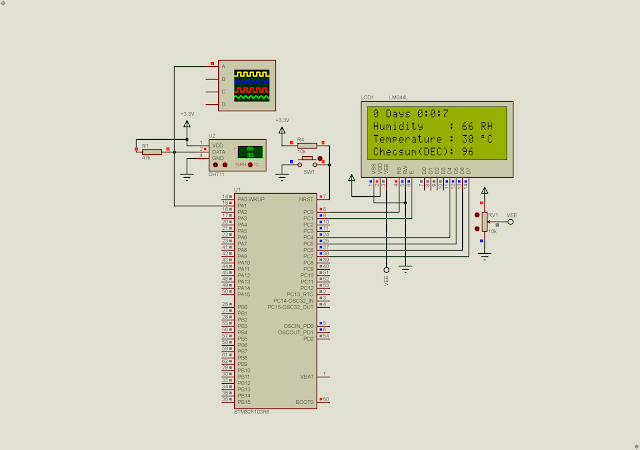Overview
The STM32F103R6 has up to two USART(Universal Synchronous/Asynchronous Receiver/Transmitter) communication modules, USART1 and USART2. These communication interfaces could be configured as synchronous or asynchronous transmission. Synchronous transmission uses a share clock line that synchronize with data.
 |
| A serial communication between two devices using a shared clock source
|
 |
| The timing diagram of a serial communication without a dedicated clock line
|
 |
| The signaling difference between a USART and a UART
|
UART is more convenient than USART because it does not require clock line over the communication interface. In some case it requires more control lines. For electronic hobbyists it is widely used with some device such as,
- the Bluetooth module,
- the Arduino serial interface that use as program uploading and serial data transmission,
- the ESP8266 WiFi module,
- the Nextion HMI (Human Machine Interface)
- the GSM module.
The Baud Rate (bits per second) is the numbers of data bits transferred per second. The STM32F1xx has the following Baud Rate.
 |
| stm32f101xx-stm32f102xx-stm32f103xx-stm32f105xx-and-stm32f107xx- standard Baud Rate |
Using the STM32CubeIDE and its CubeHal, the programmer doesn't need to calculate and configure its internal register as the IDE has a code configuring tool.
UART Programming In STM32CubeIDE Example
There are a lot of library functions in the STM32CubeIDE especially the HAL(Hardware Abstraction Layer) libraries. We still able use ARM Cortex-M3 legacy libraries in this IDE. The following APIs are belong to the IO operation functions group,
- HAL_UART_Transmit()- HAL_UART_Receive()
- HAL_UART_Transmit_IT()
- HAL_UART_Receive_IT()
- HAL_UART_Transmit_DMA()
- HAL_UART_Receive_DMA()
- HAL_UART_DMAPause()
- HAL_UART_DMAResume()
- HAL_UART_DMAStop()
- HAL_UARTEx_ReceiveToIdle()
- HAL_UARTEx_ReceiveToIdle_IT()
- HAL_UARTEx_ReceiveToIdle_DMA()
- HAL_UARTEx_GetRxEventType()
- HAL_UART_Abort()
- HAL_UART_AbortTransmit()
- HAL_UART_AbortReceive()
- HAL_UART_Abort_IT()
However there are additional function such as, Peripheral Control function, Peripheral State and Errors functions group.
In this example I will use a few functions,
- HAL_UART_Init (UART_HandleTypeDef * huart)
For example HAL_UART_Init (&huart1) , or HAL_UART_Init (&huart2)
- HAL_UART_Transmit (UART_HandleTypeDef * huart, const uint8_t * pData, uint16_t
Size, uint32_t Timeout)
For example HAL_UART_Transmit(&huart1,"Hello",5,1000)
- HAL_UART_Receive (UART_HandleTypeDef * huart, uint8_t * pData, uint16_t Size,
uint32_t Timeout)
For example HAL_UART_Receive(&huart1,myData,1,1000)
I will show a simple programming using CubeHAL. The firmware will be use with Proteus Simulator.
 |
| Simulating Program - Virtual Terminal Acts As UART Receiver/Transmitter. |
- 1 LED1 ON
- 2 LED1 OFF
- 3 LED2 ON
- 4 LED2 OFF
Now we will start writing the program for this example by creating a new STM32 project. Click on the USART1 in device configuration tool and select Asynchronous in Mode combo box.
 |
| USART1 Configuration |
 |
| GPIO Setting |
After the code generation is created we will need to add some user codes in the main.c file.
It requires 6.24KB of Flash and 1.62KB of RAM. Click here to download its source file.



